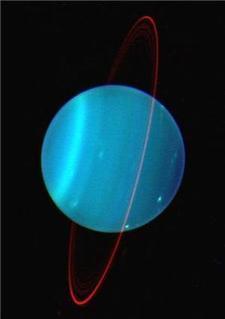
In my astronomy class, we have just recently leanerd about the planets, and how there are the two kinds. There are the Jovian planets and the Terrestrial planets. I got really interested in learning about them, so when i had to write a blog about them, i got excited! In my search to find out more about the planets I was to do my blog on, I found this very interesting article and decided that I had to write about it.
Uranus is part of the Jovian planets, it is the seventh planet from the sun. There is one thing very different about Uranus, its tilt. It has a tilt of 97.77 degrees, and because of this it is kind of the odd ball out in the solar system. The present theory that we have all grown to know and love is that Uranus was knocked on its side by a single large impact, but now there is a new theory that states early in its life Uranus experienced a succession of small punches instead of a single knock-out blow.
Uranus is unusual in that its spin axis is inclined by 98 degrees compared to its orbital plane around the Sun. This is far greater than other planets, such as Jupiter (3 degrees), Earth (23 degrees), or Saturn and Neptune (29 degrees). Uranus is, in effect, spinning on its side.The generally accepted theory is that in the past a body a few times more massive than Earth collided with Uranus, knocking the planet on its side. There is, however, one significant flaw in this notion: the moons of Uranus should have been left orbiting in their original angles, but they too lie at almost exactly 98 degrees.
This long-standing mystery has been solved by an international team of scientists led by Alessandro Morbidelli. Morbidelli and his team used simulations to reproduce various impact scenarios in order to discover the most likely cause of Uranus' tilt. They discovered that if Uranus had been hit when still surrounded by a protoplanetary disk, the material from which the moons would form, then the disk would have reformed into a fat doughnut shape around the new, highly-tilted equatorial plane. The collisions within the disk would have flattened the doughnut, which would then go onto form the moons in the positions we see today. However, the simulation threw up an unexpected result. in the first scenario, the moons displayed retrograde motion, (which i can explain to you because i have learned it in class) it means they orbited in the opposite direction to that which we observe. Morbidelli's group tweaked their parameters in order to explain this. The surprising discovery was that if Uranus was not tilted by one hit, as it is commonly thought to be, but rather was bumped by at least two smaller collisions then there is a much higher probability of seeing the moons orbit in the direction we observe.